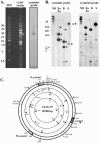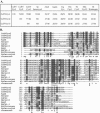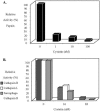A virus essential for insect host-parasite interactions encodes cystatins
- PMID: 16014938
- PMCID: PMC1181612
- DOI: 10.1128/JVI.79.15.9765-9776.2005
A virus essential for insect host-parasite interactions encodes cystatins
Abstract
Cotesia congregata is a parasitoid wasp that injects its eggs in the host caterpillar Manduca sexta. In this host-parasite interaction, successful parasitism is ensured by a third partner: a bracovirus. The relationship between parasitic wasps and bracoviruses constitutes one of the few known mutualisms between viruses and eukaryotes. The C. congregata bracovirus (CcBV) is injected at the same time as the wasp eggs in the host hemolymph. Expression of viral genes alters the caterpillar's immune defense responses and developmental program, resulting in the creation of a favorable environment for the survival and emergence of adult parasitoid wasps. Here, we describe the characterization of a CcBV multigene family which is highly expressed during parasitism and which encodes three proteins with homology to members of the cystatin superfamily. Cystatins are tightly binding, reversible inhibitors of cysteine proteases. Other cysteine protease inhibitors have been described for lepidopteran viruses; however, this is the first description of the presence of cystatins in a viral genome. The expression and purification of a recombinant form of one of the CcBV cystatins, cystatin 1, revealed that this viral cystatin is functional having potent inhibitory activity towards the cysteine proteases papain, human cathepsins L and B and Sarcophaga cathepsin B in assays in vitro. CcBV cystatins are, therefore, likely to play a role in host caterpillar physiological deregulation by inhibiting host target proteases in the course of the host-parasite interaction.
Figures







Similar articles
-
Viral cystatin evolution and three-dimensional structure modelling: a case of directional selection acting on a viral protein involved in a host-parasitoid interaction.BMC Biol. 2008 Sep 10;6:38. doi: 10.1186/1741-7007-6-38. BMC Biol. 2008. PMID: 18783611 Free PMC article.
-
Identification of parasite-responsive cysteine proteases in Manduca sexta.Biol Chem. 2009 May-Jun;390(5-6):493-502. doi: 10.1515/BC.2009.061. Biol Chem. 2009. PMID: 19361282
-
Functional annotation of Cotesia congregata bracovirus: identification of viral genes expressed in parasitized host immune tissues.J Virol. 2014 Aug;88(16):8795-812. doi: 10.1128/JVI.00209-14. Epub 2014 May 28. J Virol. 2014. PMID: 24872581 Free PMC article.
-
Cystatins from filarial parasites: evolution, adaptation and function in the host-parasite relationship.Int J Biochem Cell Biol. 2008;40(6-7):1389-98. doi: 10.1016/j.biocel.2007.11.012. Epub 2007 Dec 4. Int J Biochem Cell Biol. 2008. PMID: 18249028 Review.
-
Unfolding the evolutionary story of polydnaviruses.Virus Res. 2006 Apr;117(1):81-9. doi: 10.1016/j.virusres.2006.01.001. Epub 2006 Feb 3. Virus Res. 2006. PMID: 16460826 Review.
Cited by
-
Evolutionary mechanisms driving the evolution of a large polydnavirus gene family coding for protein tyrosine phosphatases.BMC Evol Biol. 2012 Dec 27;12:253. doi: 10.1186/1471-2148-12-253. BMC Evol Biol. 2012. PMID: 23270369 Free PMC article.
-
Parasitism of an insect Manduca sexta L. alters feeding behaviour and nutrient utilization to influence developmental success of a parasitoid.J Comp Physiol B. 2008 May;178(4):515-27. doi: 10.1007/s00360-007-0244-6. Epub 2008 Jan 15. J Comp Physiol B. 2008. PMID: 18196249
-
Viral cystatin evolution and three-dimensional structure modelling: a case of directional selection acting on a viral protein involved in a host-parasitoid interaction.BMC Biol. 2008 Sep 10;6:38. doi: 10.1186/1741-7007-6-38. BMC Biol. 2008. PMID: 18783611 Free PMC article.
-
Blurring borders: innate immunity with adaptive features.Clin Dev Immunol. 2007;2007:83671. doi: 10.1155/2007/83671. Clin Dev Immunol. 2007. PMID: 18317532 Free PMC article. Review.
-
Accidental genetic engineers: horizontal sequence transfer from parasitoid wasps to their Lepidopteran hosts.PLoS One. 2014 Oct 8;9(10):e109446. doi: 10.1371/journal.pone.0109446. eCollection 2014. PLoS One. 2014. PMID: 25296163 Free PMC article.
References
-
- Abe, K., Y. Emori, H. Kondo, K. Suzuki, and S. Arai.c 1987. Molecular cloning of a cysteine proteinase inhibitor of rice (oryzacystatin). Homology with animal cystatins and transient expression in the ripening process of rice seeds. J. Biol. Chem. 262:16793-16797. - PubMed
-
- Abrahamson, M., M. Alvarez-Fernandez, and C. M. Nathanson. 2003. Cystatins. Biochem. Soc. Symp. 2003:179-199. - PubMed
-
- Albrecht, U., T. Wyler, R. Pfister-Wilhelm, A. Gruber, P. Stettler, P. Heiniger, F. Kurt, D. Schümperli, and B. Lanzrein. 1994. Polydnavirus of the parasitic wasp Chelonus inanitus (Braconidae): characterization, genome organization and time point of replication. J. Gen. Virol. 75:3353-3363. - PubMed
-
- Altschul, S. F., W. Gish, W. Miller, E. W. Myers, and D. J. Lipman. 1990. Basic local alignment search tool. J. Mol. Biol. 215:403-410. - PubMed
Publication types
MeSH terms
Substances
Associated data
- Actions
LinkOut - more resources
Full Text Sources

